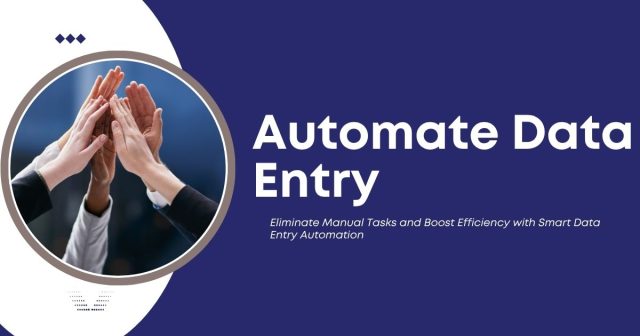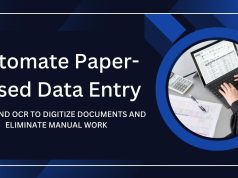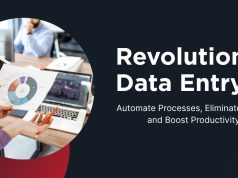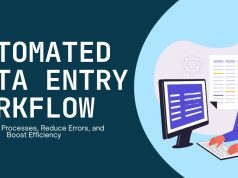Manual data entry consumes countless hours of your workday. You copy information from emails to spreadsheets, transfer customer details between systems, and update databases with repetitive keystrokes. Sound familiar?
Microsoft Power Automate transforms this tedious reality into automated efficiency. This cloud-based service connects your favorite apps and services, creating workflows that handle data entry tasks without human intervention. Whether you’re managing customer information, processing invoices, or updating inventory records, Power Automate can eliminate the manual work that’s eating away at your productive hours.
This guide explores how Power Automate revolutionizes data entry processes, walks you through practical implementation strategies, and demonstrates real-world applications that deliver immediate results. By the end, you’ll understand exactly how to reclaim hours of your week while reducing errors and improving data accuracy.
Understanding Power Automate for Data Entry
Power Automate operates on a simple premise: when something happens in one app, automatically trigger an action in another. For data entry specifically, this means capturing information from various sources and seamlessly transferring it to your target systems.
The platform supports hundreds of connectors, including Microsoft 365 applications, Google Workspace, Salesforce, SharePoint, and countless third-party services. These connections enable sophisticated data workflows that would otherwise require extensive manual effort or custom programming.
Key Components of Automated Data Entry
Triggers initiate your automated workflows. Common data entry triggers include new email arrivals, form submissions, file uploads, or scheduled time intervals. When a trigger activates, Power Automate begins executing your predefined sequence of actions.
Actions represent the actual work your automation performs. Data entry actions might include creating new records, updating existing information, sending notifications, or generating reports. Each action can use data from previous steps, creating dynamic workflows that adapt to incoming information.
Conditions add intelligence to your automations. They allow workflows to make decisions based on data content, routing information differently depending on specific criteria. For example, you might categorize customer inquiries by urgency level or route orders to different fulfillment centers based on shipping addresses.
Setting Up Your First Power Automate Data Entry Workflow
Creating your first automated data entry process requires careful planning and systematic execution. Start by identifying a simple, repetitive task that currently consumes significant time.

Planning Your Automation Strategy
Document your current manual process step by step. Note where data originates, how it gets processed, and where it ultimately needs to reside. This mapping exercise reveals automation opportunities and potential complications before you begin building.
Consider data validation requirements early in your planning. Automated systems need clear rules for handling incomplete information, duplicate entries, or data that doesn’t match expected formats. Establishing these parameters upfront prevents workflow failures and ensures consistent data quality.
Building Your Workflow
Access Power Automate through your Microsoft 365 subscription or create a standalone account. The platform offers both automated flows (triggered by events) and instant flows (activated manually) for different data entry scenarios.
Select an appropriate trigger based on your data source. Email-based triggers work well for processing customer inquiries or supplier updates. Form-based triggers excel at capturing structured information from surveys or applications. File-based triggers handle batch processing scenarios where data arrives in spreadsheets or documents.
Configure your actions to process and route data appropriately. Use the “Parse JSON” action to extract specific information from complex data structures. Apply the “Compose” action to format data according to your target system’s requirements. Leverage “Condition” actions to implement business logic and data validation rules.
Test your workflow thoroughly with sample data before deploying it to production. Power Automate’s testing features allow you to step through each action and verify that data transforms correctly at every stage.
Common Power Automate Data Entry Use Cases
Customer Relationship Management
Automatically capture leads from web forms and create corresponding records in your CRM system. When potential customers submit contact forms on your website, Power Automate can extract their information and immediately add them to your sales pipeline with appropriate lead scores and assignment rules.
Update customer records based on email interactions or support ticket resolutions. This ensures your team always has current information without manual data synchronization between systems.
Financial Data Processing
Process expense reports by extracting data from emailed receipts and updating financial tracking spreadsheets. Power Automate can read receipt images using AI Builder, categorize expenses automatically, and flag items requiring manual review.
Automate invoice processing by capturing vendor information from email attachments and creating entries in your accounting system. This reduces processing time and minimizes data entry errors that can affect financial reporting accuracy.
Financial Data Processing
Inventory and Order Management
Sync inventory levels between your e-commerce platform and internal tracking systems. When products sell online, automatically update stock quantities in your warehouse management system and trigger reorder notifications when items reach minimum thresholds.
Process customer orders by extracting information from various sales channels and consolidating everything into a unified fulfillment system. This eliminates the need to manually check multiple platforms and reduces order processing delays.
Human Resources Administration
Streamline employee onboarding by automatically creating user accounts, assigning equipment, and updating personnel databases when new hire paperwork arrives. This ensures consistent onboarding experiences while reducing administrative workload.
Process timesheet submissions by extracting hours worked from various time tracking systems and updating payroll databases. Automated validation rules can flag unusual entries for manager review while routine submissions process without intervention.
Best Practices for Power Automate Data Entry
Error Handling and Data Validation
Implement robust error handling to manage situations where source data doesn’t match expected formats. Use “Try-Catch” patterns to gracefully handle exceptions and continue processing other records when individual items fail.
Validate critical data fields before committing information to target systems. Check for required fields, verify email addresses follow proper formats, and ensure numeric values fall within acceptable ranges. Failed validations should trigger notifications to appropriate personnel for manual review.
Performance Optimization
Batch similar operations together when possible to reduce API calls and improve processing speed. Instead of updating records individually, collect changes and apply them in groups when your target system supports batch operations.
Use parallel branches judiciously to avoid overwhelming external systems with simultaneous requests. While parallel processing can improve performance, too many concurrent operations may trigger rate limiting or system instability.
Security and Compliance Considerations
Implement appropriate access controls to ensure only authorized personnel can modify or view sensitive automation workflows. Use service accounts with minimal required permissions rather than personal accounts that might change when employees leave the organization.
Document data handling practices to support compliance requirements. Many industries have specific regulations governing how personal or financial information gets processed and stored. Your automation workflows should align with these requirements from the design phase forward.
Track key metrics to quantify your automation’s impact on productivity and data quality. Monitor processing times, error rates, and volume of records handled to demonstrate value and identify improvement opportunities.
Key Performance Indicators
Time Savings: Compare manual processing time against automated completion time for equivalent tasks. Document these savings across different types of data entry scenarios to build a comprehensive picture of efficiency gains.
Error Reduction: Measure data accuracy improvements by comparing manual entry error rates with automated processing results. Automated systems typically achieve higher consistency once properly configured and tested.
Processing Volume: Track the number of records your automations handle over time. Growing volumes without proportional increases in manual effort demonstrate scalability benefits.
Iterative Enhancement
Regularly review and refine your workflows based on changing business requirements and user feedback. Power Automate’s built-in analytics provide insights into flow performance and failure patterns that can guide optimization efforts.
Consider expanding successful automations to handle additional scenarios or integrate with new systems. Start with simple use cases and gradually add complexity as your team becomes more comfortable with the platform’s capabilities.
Troubleshooting Common Power Automate Data Entry Issues
Connection and Authentication Problems
Authentication failures often occur when service credentials expire or change. Establish regular maintenance schedules to review and refresh connection credentials before they cause workflow interruptions.
API rate limiting can cause intermittent failures when processing large volumes of data. Implement delays between operations or redesign workflows to spread processing over longer time periods.
Data Format and Mapping Challenges
Source data formats may change unexpectedly, breaking existing workflows. Build flexibility into your data extraction logic by using dynamic expressions that can adapt to minor format variations.
Character encoding issues can corrupt data during transfer between systems. Specify appropriate encoding standards and test with international characters to ensure global compatibility.
Transform Your Data Entry Operations
Power Automate data entry automation delivers immediate productivity gains while establishing a foundation for broader digital transformation initiatives. Teams that embrace these tools typically see 60-80% reductions in manual data entry time, allowing staff to focus on higher-value activities that directly impact business outcomes.
Start small with a single, well-defined use case that affects your daily operations. Master the basic concepts and gradually expand your automation scope as confidence and expertise develop. The investment in learning Power Automate pays dividends through eliminated repetitive work and improved data accuracy across your organization.
Ready to reclaim your time from tedious data entry tasks? Identify your most time-consuming manual process and begin mapping out your first Power Automate workflow today.











